
llama-on-lambda
Deploy llama.cpp compatible Generative AI LLMs on AWS Lambda!
Stars: 150
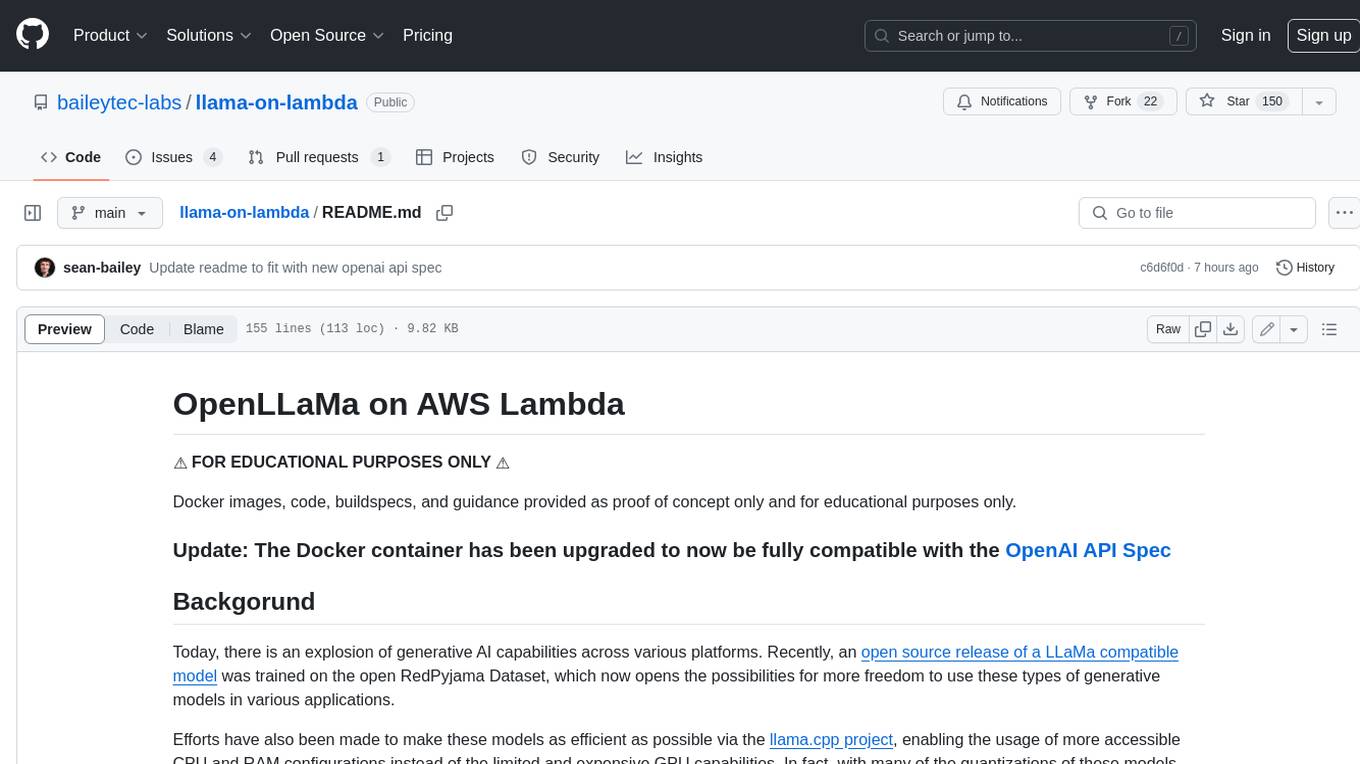
This project provides a proof of concept for deploying a scalable, serverless LLM Generative AI inference engine on AWS Lambda. It leverages the llama.cpp project to enable the usage of more accessible CPU and RAM configurations instead of limited and expensive GPU capabilities. By deploying a container with the llama.cpp converted models onto AWS Lambda, this project offers the advantages of scale, minimizing cost, and maximizing compute availability. The project includes AWS CDK code to create and deploy a Lambda function leveraging your model of choice, with a FastAPI frontend accessible from a Lambda URL. It is important to note that you will need ggml quantized versions of your model and model sizes under 6GB, as your inference RAM requirements cannot exceed 9GB or your Lambda function will fail.
README:
Docker images, code, buildspecs, and guidance provided as proof of concept only and for educational purposes only.
Update: The Docker container has been upgraded to now be fully compatible with the OpenAI API Spec
Today, there is an explosion of generative AI capabilities across various platforms. Recently, an open source release of a LLaMa compatible model was trained on the open RedPyjama Dataset, which now opens the possibilities for more freedom to use these types of generative models in various applications.
Efforts have also been made to make these models as efficient as possible via the llama.cpp project, enabling the usage of more accessible CPU and RAM configurations instead of the limited and expensive GPU capabilities. In fact, with many of the quantizations of these models, you can provide reasonably responsive inferences on as little as 4-6 GB of RAM on a CPU, and even on an Android smartphone, if you're patient enough.
This has sparked an idea -- What if we could have a scalable, serverless LLM Generative AI inference engine? After some experimentation, it turns out that not only is it possible, but it also works quite well!
The premise is rather simple: deploy a container which can run the llama.cpp converted models onto AWS Lambda. This gives the advantages of scale which Lambda provides, minimizing cost and maximizing compute availability for your project. This project contains the AWS CDK code to create and deploy a Lambda function leveraging your model of choice**, with a FastAPI frontend accessible from a Lambda URL. Lambda also provides a great case for developers and businesses which want to deploy functions such as this: You get 400k GB-s of Lambda Compute each month for free, meaning with proper tuning, you can have scalable inference of these Generative AI LLMs for minimal cost.
Note that you will need to have ggml quantized versions of your model, and you will likely need model sizes which are under 6GB. Regardless, your inference RAM requirements cannot exceed 9GB, or your Lambda function will fail
Wait, what?
Lambda Docker Containers have a hard limit of 10GB in size, but that offers plenty of room for these models. However, the models cannot be stored in the proper invocation directory, but you can place them in /opt. By pre-baking the models ino the /opt directory, you can include the entire package into your function without needing extra storage.
- You need Docker installed on your system and running. You will be building a container.
- Go to Huggingface and pick out a GGML quantized model compatible with llama.cpp.
- You need to have the AWS CDK installed on your system, as well as an AWS account, proper credentials, etc.
- Python3.9+
The default installation deploys the new OpenAI API compatible endpoint. See the Usage sectionfor more details. If you would like to leverage the original legacy version of this deployment, simply rename the llama_lambda/legacy_app.py to llama_lambda/app.py and everything should run normally. I recommend you make a copy of the original app.py. Maybe call it something like "newapp.py"?
Once you've installed the requirements, on Mac/Linux:
- Download this repository.
- cd into the root directory of this repo (/wherever/you/downloaded/it/llama-on-lambda)
cd ./llama_lambdachmod +x install.sh./install.sh- Follow the prompts, and when complete, the CDK will provide you with a Lambda Function URL to test the function.
Note that this could take quite some time to build (on an M1 MBP 16GB it took 1600s to complete, so go get a coffee.)
For Windows users, ensure you have the requirements properly installed, and do the following:
- Download this repository
- Open a command prompt terminal, and cd into the root directory of this repo.
cd ./llama_lambda-
powershell -File ./install.ps1- Note that if you get a permissions based error, you can manually open the install.ps1 script and type out the commands manually. You will need to look into
Set-ExecutionPolicy, and I will not be providing security recommendations for your system.
- Note that if you get a permissions based error, you can manually open the install.ps1 script and type out the commands manually. You will need to look into
- Follow the prompts, and when complete, the CDK will provide you with a Lambda Function URL to test the function.
Since the original development of this project, there has been an explosion in the development of the ggmml project into the gguf project, and all the trappings in between. I've updated the docker container and the cdk code to deploy a new optimized Lambda function which is fully compatible with the OpenAI API Spec using the llama-cpp-python library. This means you can deploy your function using a model (I recommend a 3B or smaller, the current configuration is set up for a 1.6B) and actually have it stream at 3-6 Tokens Per Second. Here's a code example on how you can interact with your endpoint:
!pip install openai requests
from openai import OpenAI
import datetime
import requests
import time
import random
yourUrl="<The Lambda function URL without /docs>"
promptmessage = "What is the capital of France?"
yourAPIKey="<the key you specified in the config.json>"
# Configuration Settings - Adjusted for local LLM or compatible endpoint
agentprompt="You are a helpful assistant."
prompt_message=promptmessage
if not yourUrl.endswith("/v1"):
yourUrl = yourUrl + "/v1"
client=OpenAI(api_key=yourAPIKey,base_url=yourUrl)
starttime=time.time()
stream = client.chat.completions.create(
model="fastmodel", #fastmodel or strongmodel
messages= [
{"content": agentprompt, "role": "system"},
{"content": prompt_message, "role": "user"},
],
stream=True,
)
firstchunk=True
totalchunks=0
try:
for chunk in stream:
#print(chunk)
if firstchunk:
timetofirstchunk=time.time()
firstchunk=False
if "[/" in str(chunk.choices[0].delta.content):
break
print(chunk.choices[0].delta.content or "", end="")
totalchunks+=1
except Exception as e:
print(str(e))
endtime=time.time()
tps = totalchunks/(endtime-starttime)
try:
firstchunktime = timetofirstchunk - starttime
except:
firstchunktime = "N/A"
print("")
print("Tokens per second:")
print(tps)
print("Time to first chunk (seconds):")
print(firstchunktime)
print("Total Time (seconds): ")
print(endtime-starttime)
print("Total Chunks (tokens): ")
print(totalchunks)
This way, you don't need to create custom code to interact with your endpoint, instead using industry standard code. And, because it's compatible with the OpenAI API Spec, anything which leverages it (such as LangChain) will be fully compatible, so long as you point the client to your URL and API key.
Open your browser and navigate to the URL that you were provided by the CDK output and you should be presented with a simple FastAPI frontend allowing you to test out the functionality of your model. Note that it does NOT load the model until you use the /prompt endpoint of your API, so if there are problems with your model, you won't know until you get to that point. This is by design so you can see if the Lambda function is working properly before testing the model.
Here's what the different input values do:
text -- This is the text you'd like to prompt the model with. Currently, it is pre-prompt loaded with a question/response text, which you can modify if you'd like from the llama_cpp_docker/main.py file.
prioroutput -- You can provide the previous output of the model into this input if you'd like it to continue where it left off. Remember to keep the same original text prompt.
tokencount -- Default at 120, but is the number of tokens the model will generate before returning output. Rule of thumb is that the lower token count, the faster the response, but the less information is contained in the response. You can tweak this to balance accordingly.
penalty -- Default at 5.5, this is the repeat penalty. Essentially, this value impacts how much the model will repeat itself in its output.
seedval -- Default at 0, this is the seed for your model. If you have it set to zero, it will choose a random seed for each generation.
This Lambda function is deployed with the largest values Lambda supports (10GB Memory). However, feel free to tweak the models, the function configuration, and the input values you want to use in order to optimize for your Lambda consumption. Remember, AWS Accounts get 400k GB-s of Lambda functions for free each month, which opens up the possibilities to have Generative AI capabilities with minimal cost. Check CloudWatch to determine what is going on with your function, and enjoy! Huge thanks to the llama.cpp and the llama-cpp-python projects, without which this project would not be possible!
For Tasks:
Click tags to check more tools for each tasksFor Jobs:
Alternative AI tools for llama-on-lambda
Similar Open Source Tools

llama-on-lambda
This project provides a proof of concept for deploying a scalable, serverless LLM Generative AI inference engine on AWS Lambda. It leverages the llama.cpp project to enable the usage of more accessible CPU and RAM configurations instead of limited and expensive GPU capabilities. By deploying a container with the llama.cpp converted models onto AWS Lambda, this project offers the advantages of scale, minimizing cost, and maximizing compute availability. The project includes AWS CDK code to create and deploy a Lambda function leveraging your model of choice, with a FastAPI frontend accessible from a Lambda URL. It is important to note that you will need ggml quantized versions of your model and model sizes under 6GB, as your inference RAM requirements cannot exceed 9GB or your Lambda function will fail.
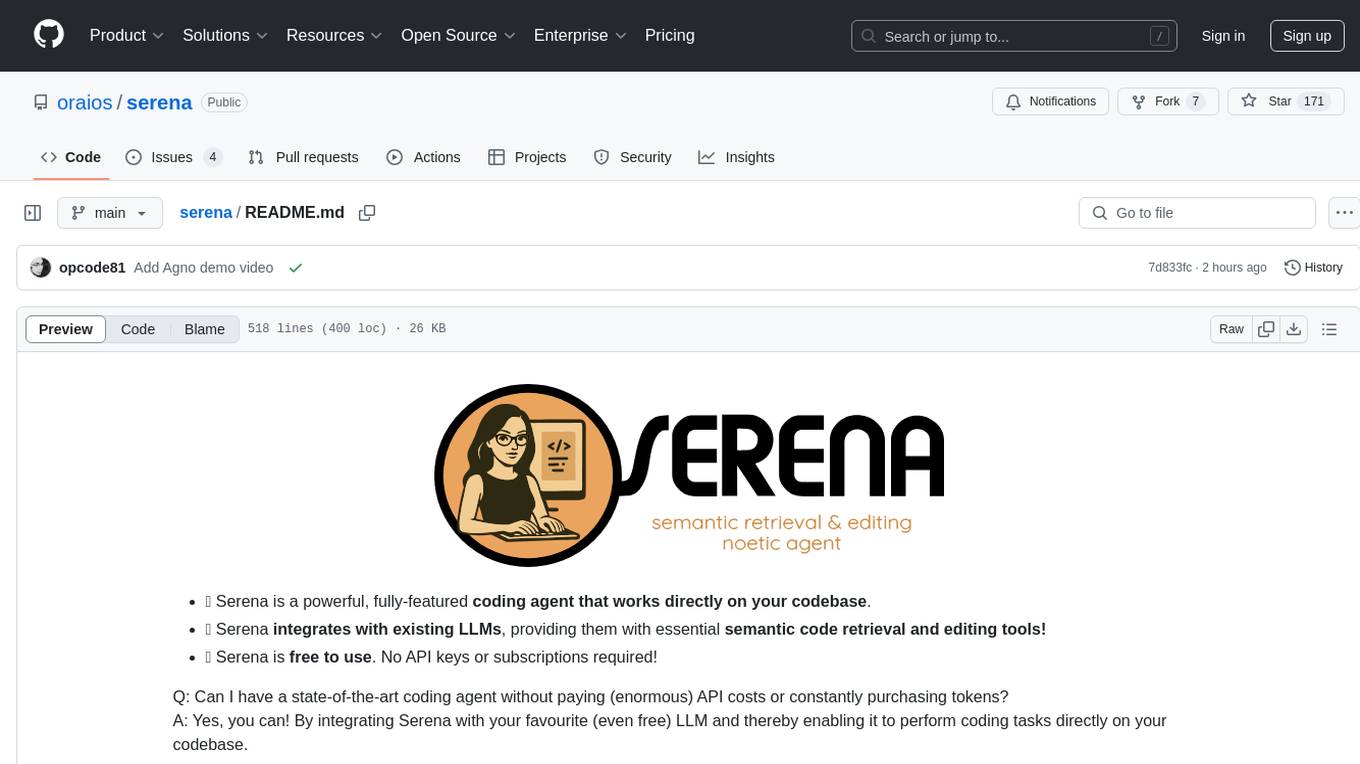
serena
Serena is a powerful coding agent that integrates with existing LLMs to provide essential semantic code retrieval and editing tools. It is free to use and does not require API keys or subscriptions. Serena can be used for coding tasks such as analyzing, planning, and editing code directly on your codebase. It supports various programming languages and offers semantic code analysis capabilities through language servers. Serena can be integrated with different LLMs using the model context protocol (MCP) or Agno framework. The tool provides a range of functionalities for code retrieval, editing, and execution, making it a versatile coding assistant for developers.
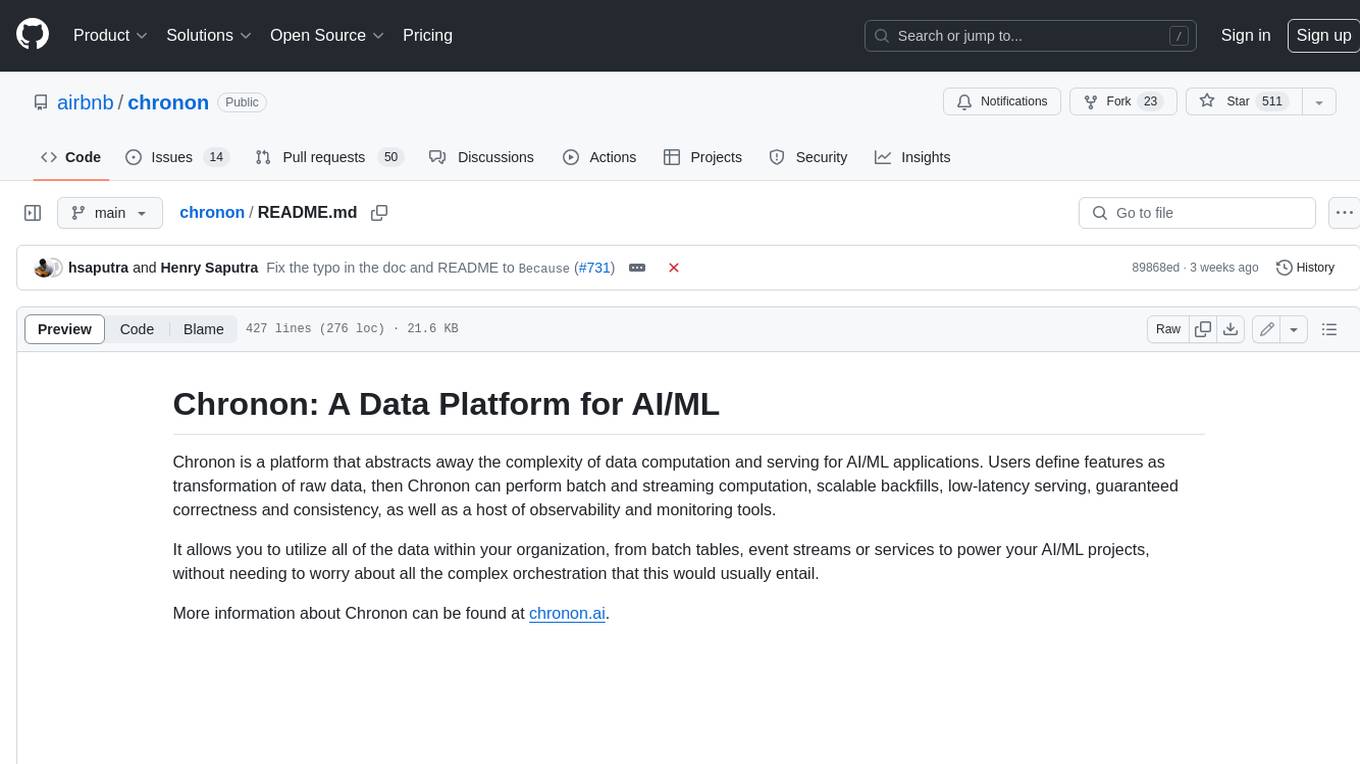
chronon
Chronon is a platform that simplifies and improves ML workflows by providing a central place to define features, ensuring point-in-time correctness for backfills, simplifying orchestration for batch and streaming pipelines, offering easy endpoints for feature fetching, and guaranteeing and measuring consistency. It offers benefits over other approaches by enabling the use of a broad set of data for training, handling large aggregations and other computationally intensive transformations, and abstracting away the infrastructure complexity of data plumbing.
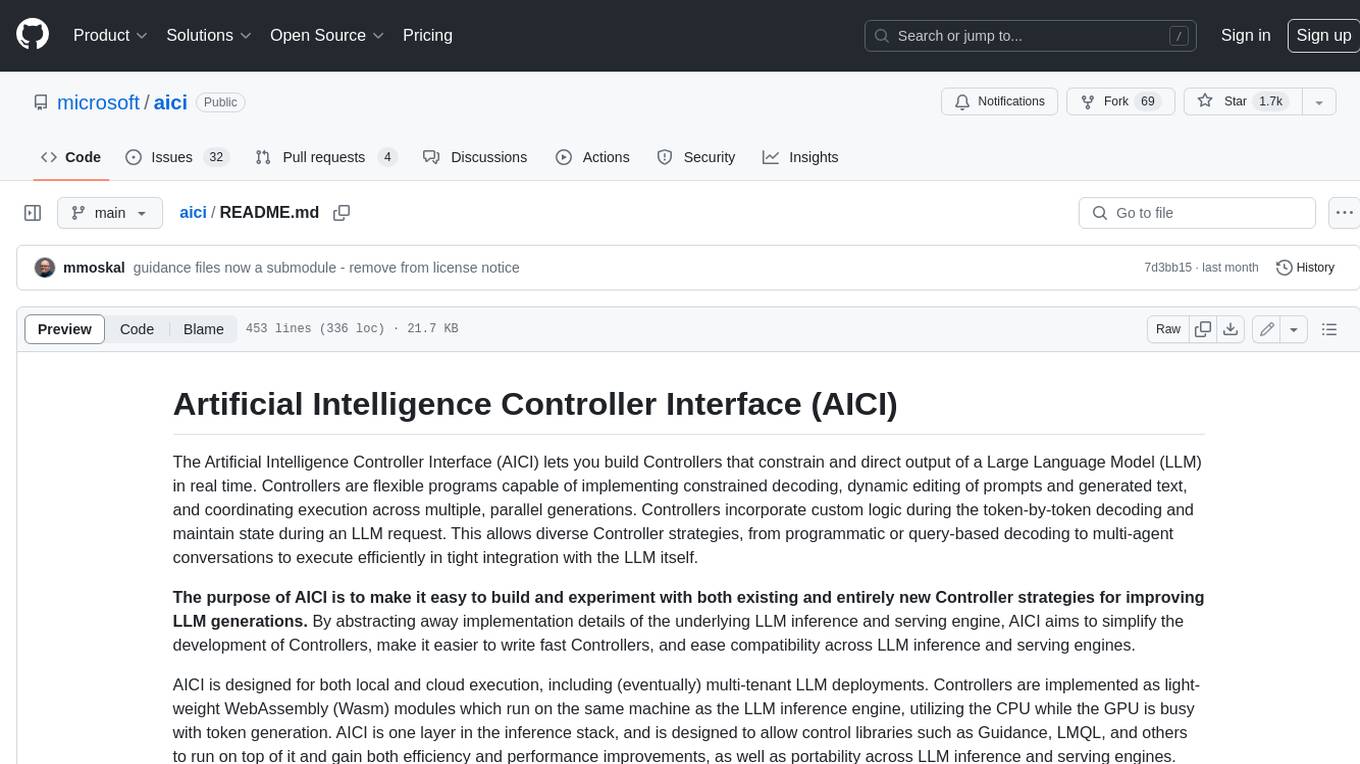
aici
The Artificial Intelligence Controller Interface (AICI) lets you build Controllers that constrain and direct output of a Large Language Model (LLM) in real time. Controllers are flexible programs capable of implementing constrained decoding, dynamic editing of prompts and generated text, and coordinating execution across multiple, parallel generations. Controllers incorporate custom logic during the token-by-token decoding and maintain state during an LLM request. This allows diverse Controller strategies, from programmatic or query-based decoding to multi-agent conversations to execute efficiently in tight integration with the LLM itself.
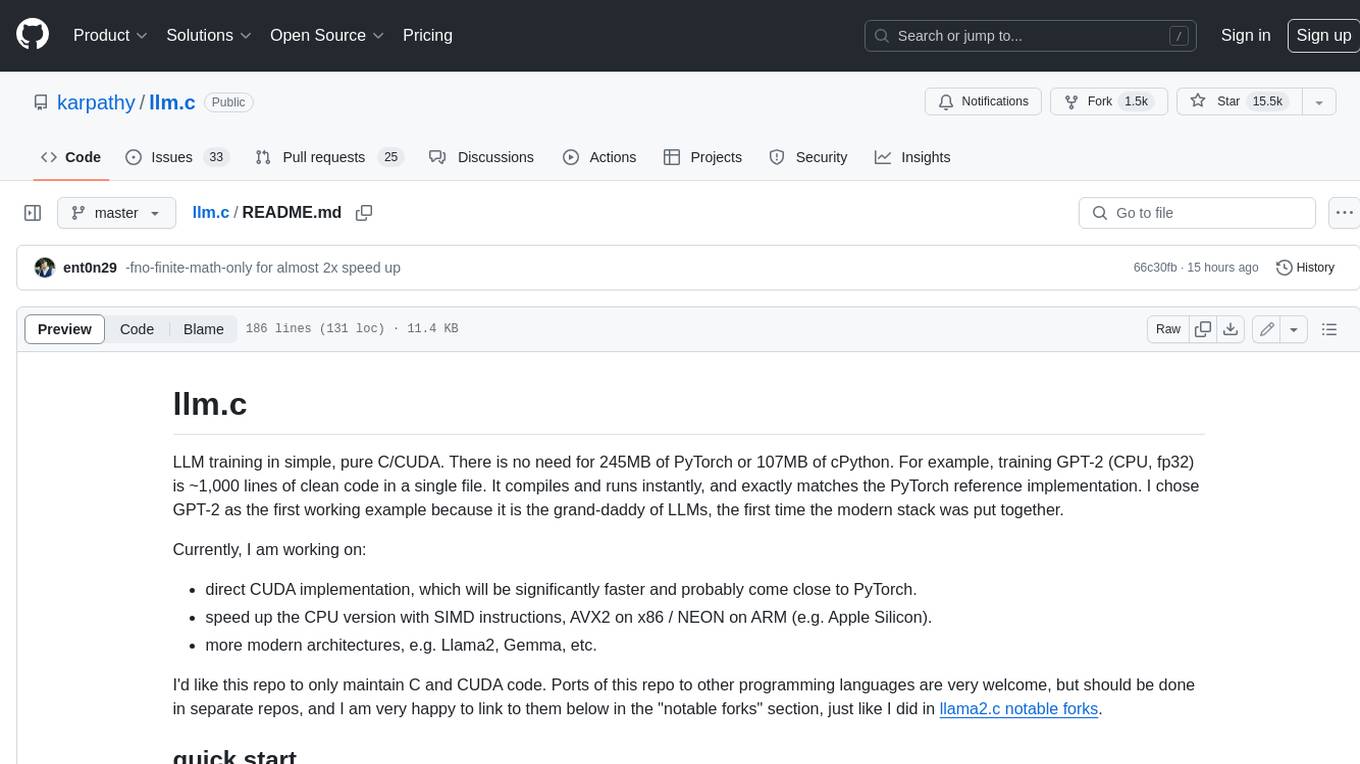
llm.c
LLM training in simple, pure C/CUDA. There is no need for 245MB of PyTorch or 107MB of cPython. For example, training GPT-2 (CPU, fp32) is ~1,000 lines of clean code in a single file. It compiles and runs instantly, and exactly matches the PyTorch reference implementation. I chose GPT-2 as the first working example because it is the grand-daddy of LLMs, the first time the modern stack was put together.
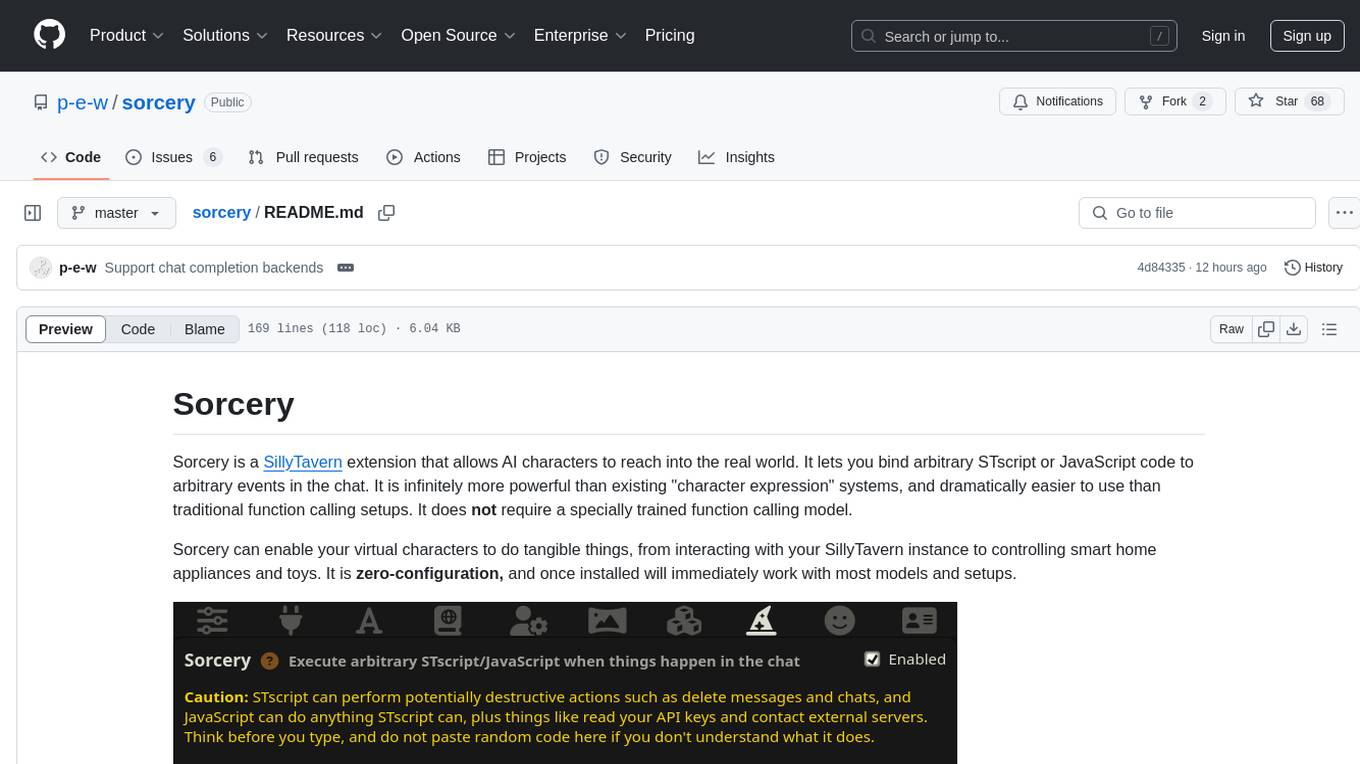
sorcery
Sorcery is a SillyTavern extension that allows AI characters to interact with the real world by executing user-defined scripts at specific events in the chat. It is easy to use and does not require a specially trained function calling model. Sorcery can be used to control smart home appliances, interact with virtual characters, and perform various tasks in the chat environment. It works by injecting instructions into the system prompt and intercepting markers to run associated scripts, providing a seamless user experience.
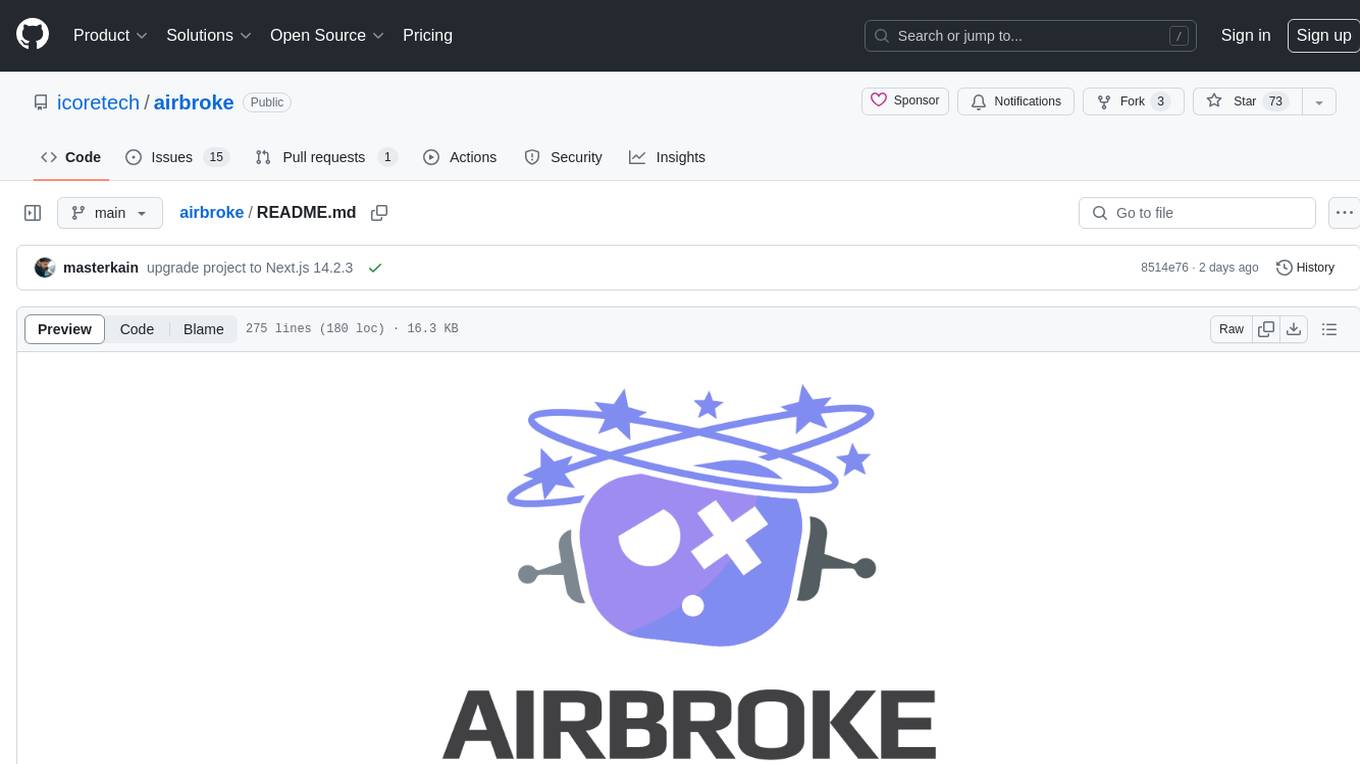
airbroke
Airbroke is an open-source error catcher tool designed for modern web applications. It provides a PostgreSQL-based backend with an Airbrake-compatible HTTP collector endpoint and a React-based frontend for error management. The tool focuses on simplicity, maintaining a small database footprint even under heavy data ingestion. Users can ask AI about issues, replay HTTP exceptions, and save/manage bookmarks for important occurrences. Airbroke supports multiple OAuth providers for secure user authentication and offers occurrence charts for better insights into error occurrences. The tool can be deployed in various ways, including building from source, using Docker images, deploying on Vercel, Render.com, Kubernetes with Helm, or Docker Compose. It requires Node.js, PostgreSQL, and specific system resources for deployment.
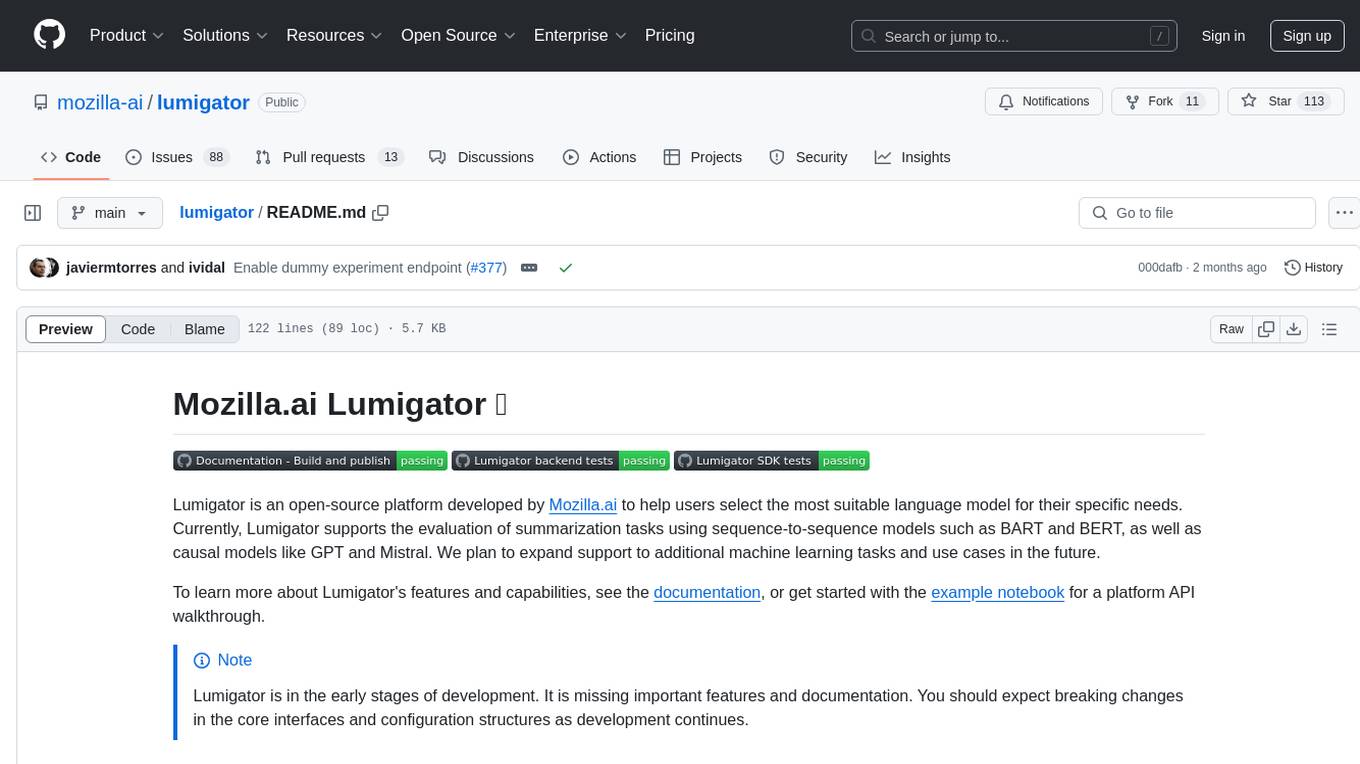
lumigator
Lumigator is an open-source platform developed by Mozilla.ai to help users select the most suitable language model for their specific needs. It supports the evaluation of summarization tasks using sequence-to-sequence models such as BART and BERT, as well as causal models like GPT and Mistral. The platform aims to make model selection transparent, efficient, and empowering by providing a framework for comparing LLMs using task-specific metrics to evaluate how well a model fits a project's needs. Lumigator is in the early stages of development and plans to expand support to additional machine learning tasks and use cases in the future.

brokk
Brokk is a code assistant designed to understand code semantically, allowing LLMs to work effectively on large codebases. It offers features like agentic search, summarizing related classes, parsing stack traces, adding source for usages, and autonomously fixing errors. Users can interact with Brokk through different panels and commands, enabling them to manipulate context, ask questions, search codebase, run shell commands, and more. Brokk helps with tasks like debugging regressions, exploring codebase, AI-powered refactoring, and working with dependencies. It is particularly useful for making complex, multi-file edits with o1pro.
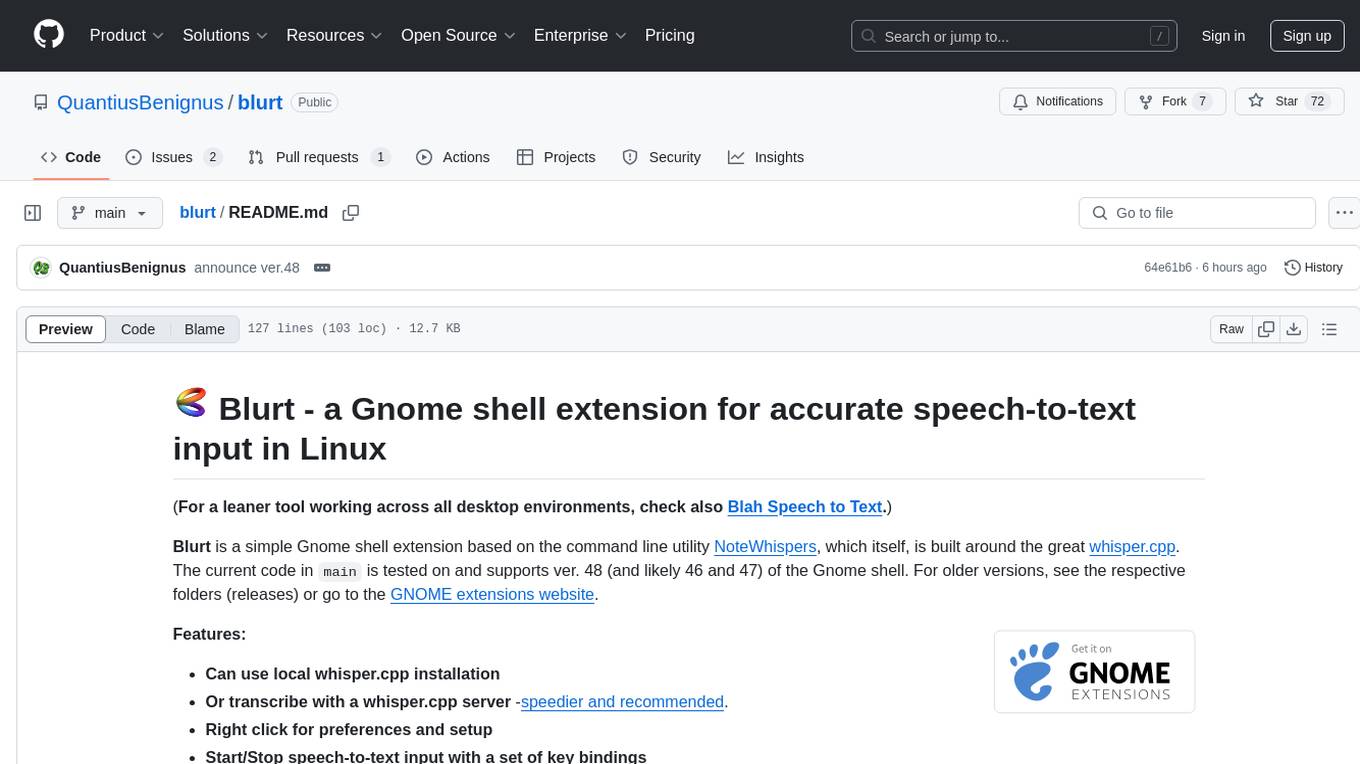
blurt
Blurt is a Gnome shell extension that enables accurate speech-to-text input in Linux. It is based on the command line utility NoteWhispers and supports Gnome shell version 48. Users can transcribe speech using a local whisper.cpp installation or a whisper.cpp server. The extension allows for easy setup, start/stop of speech-to-text input with key bindings or icon click, and provides visual indicators during operation. It offers convenience by enabling speech input into any window that allows text input, with the transcribed text sent to the clipboard for easy pasting.
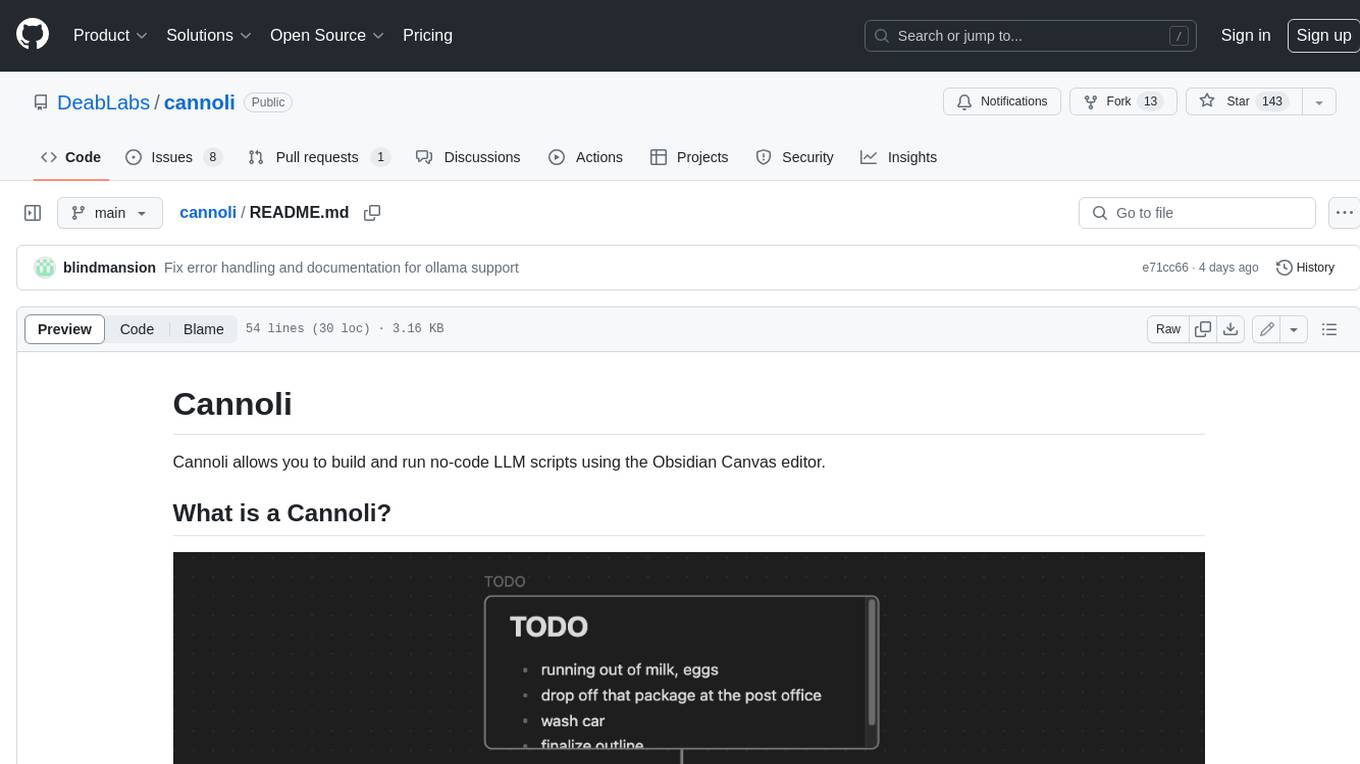
cannoli
Cannoli allows you to build and run no-code LLM scripts using the Obsidian Canvas editor. Cannolis are scripts that leverage the OpenAI API to read/write to your vault, and take actions using HTTP requests. They can be used to automate tasks, create custom llm-chatbots, and more.
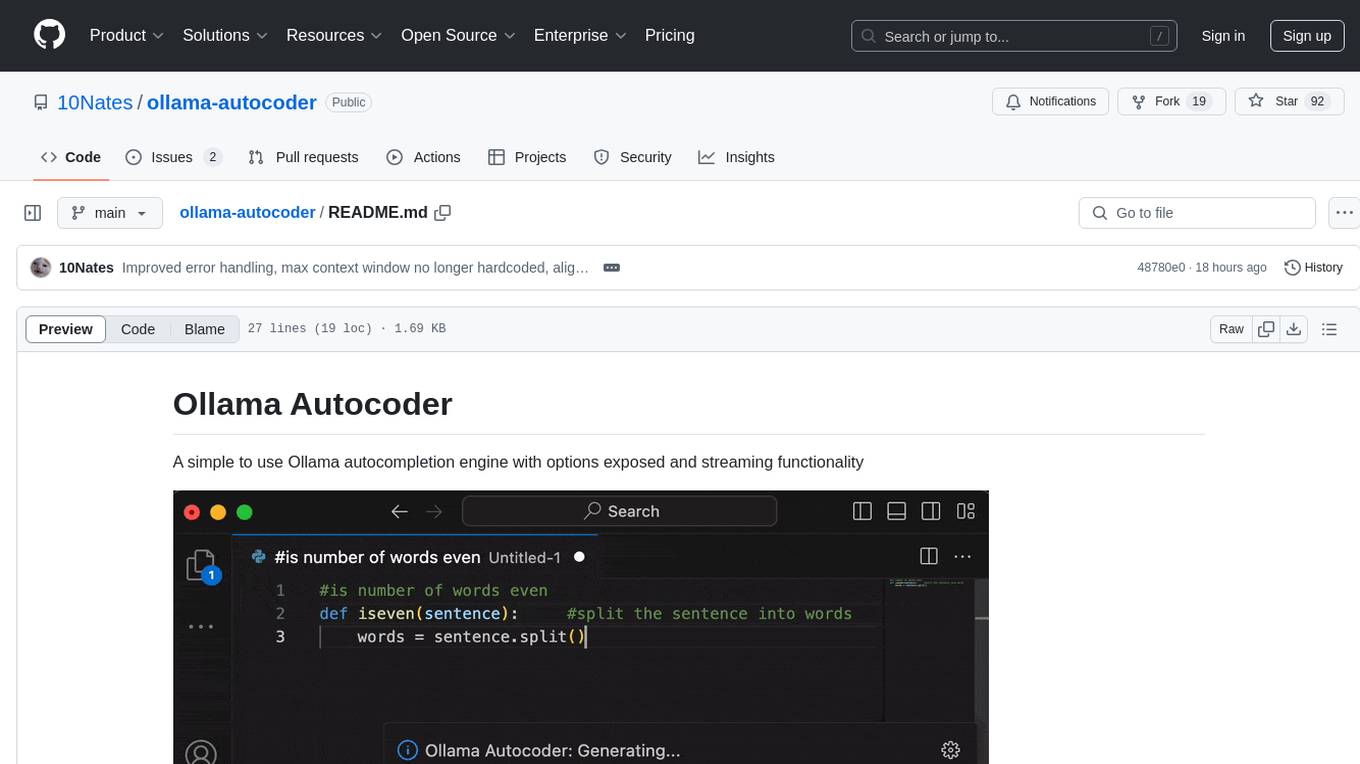
ollama-autocoder
Ollama Autocoder is a simple to use autocompletion engine that integrates with Ollama AI. It provides options for streaming functionality and requires specific settings for optimal performance. Users can easily generate text completions by pressing a key or using a command pallete. The tool is designed to work with Ollama API and a specified model, offering real-time generation of text suggestions.
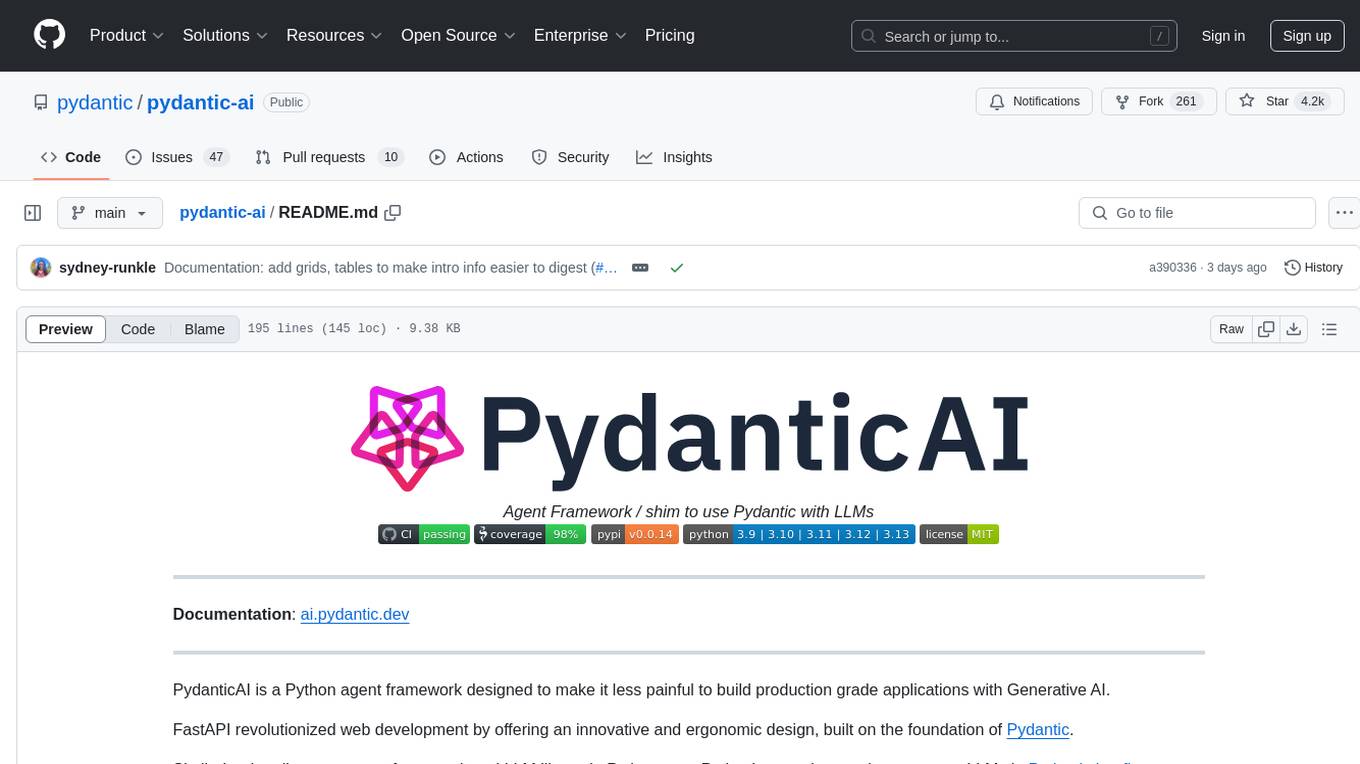
pydantic-ai
PydanticAI is a Python agent framework designed to make it less painful to build production grade applications with Generative AI. It is built by the Pydantic Team and supports various AI models like OpenAI, Anthropic, Gemini, Ollama, Groq, and Mistral. PydanticAI seamlessly integrates with Pydantic Logfire for real-time debugging, performance monitoring, and behavior tracking of LLM-powered applications. It is type-safe, Python-centric, and offers structured responses, dependency injection system, and streamed responses. PydanticAI is in early beta, offering a Python-centric design to apply standard Python best practices in AI-driven projects.
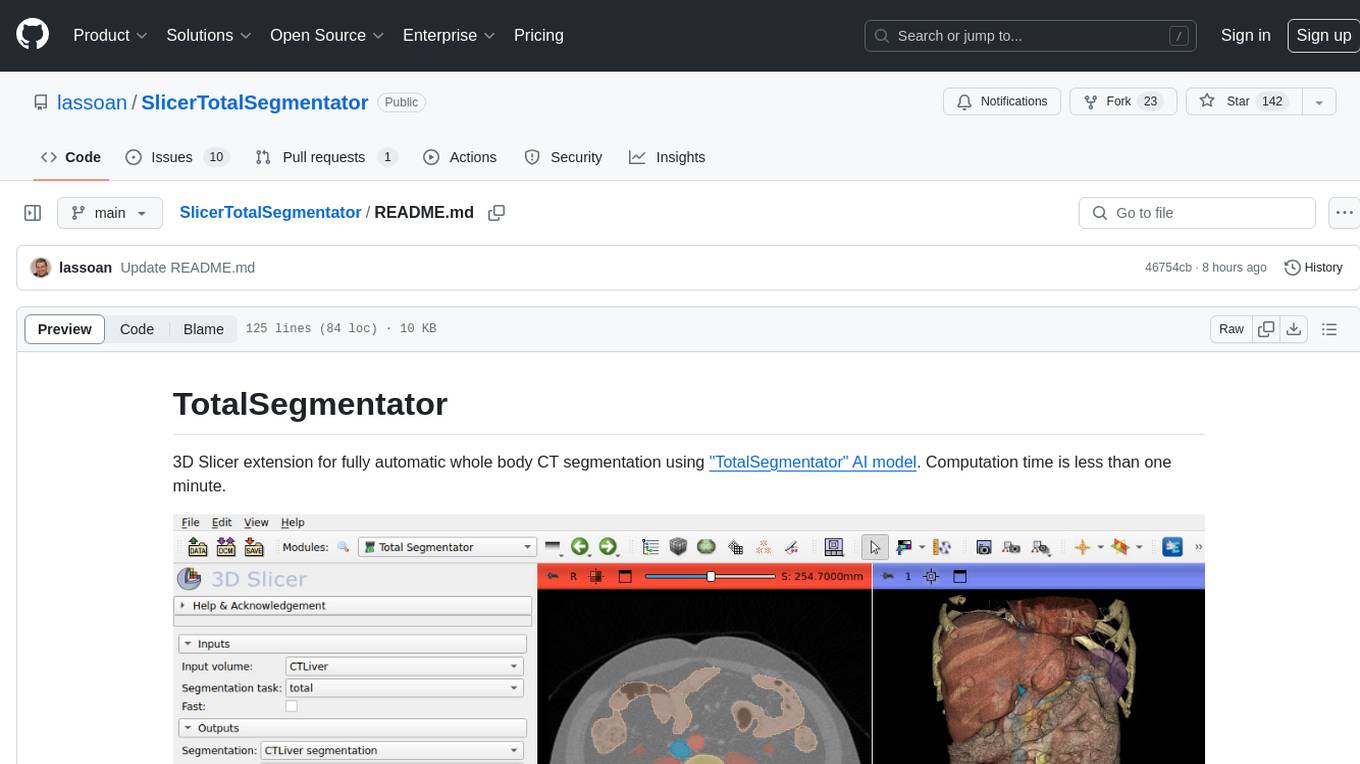
SlicerTotalSegmentator
TotalSegmentator is a 3D Slicer extension designed for fully automatic whole body CT segmentation using the 'TotalSegmentator' AI model. The computation time is less than one minute, making it efficient for research purposes. Users can set up GPU acceleration for faster segmentation. The tool provides a user-friendly interface for loading CT images, creating segmentations, and displaying results in 3D. Troubleshooting steps are available for common issues such as failed computation, GPU errors, and inaccurate segmentations. Contributions to the extension are welcome, following 3D Slicer contribution guidelines.
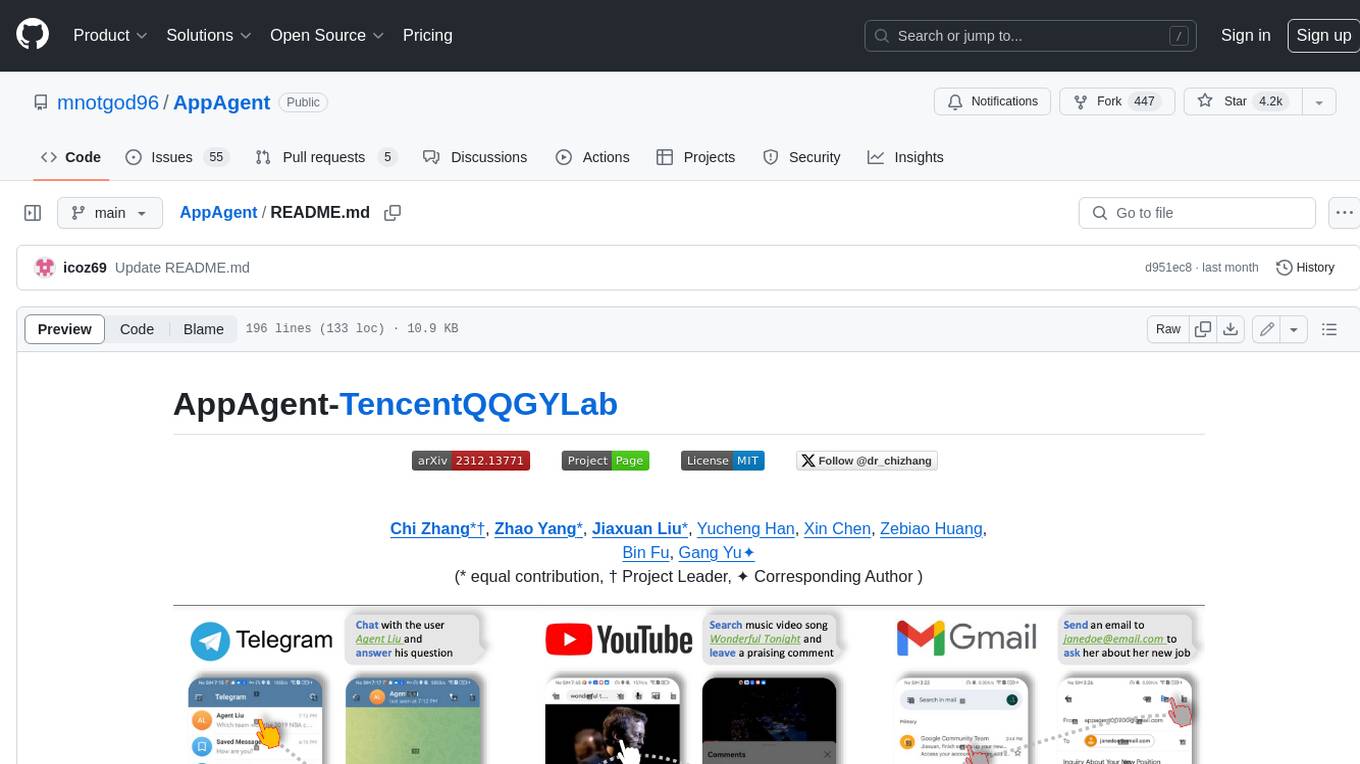
AppAgent
AppAgent is a novel LLM-based multimodal agent framework designed to operate smartphone applications. Our framework enables the agent to operate smartphone applications through a simplified action space, mimicking human-like interactions such as tapping and swiping. This novel approach bypasses the need for system back-end access, thereby broadening its applicability across diverse apps. Central to our agent's functionality is its innovative learning method. The agent learns to navigate and use new apps either through autonomous exploration or by observing human demonstrations. This process generates a knowledge base that the agent refers to for executing complex tasks across different applications.
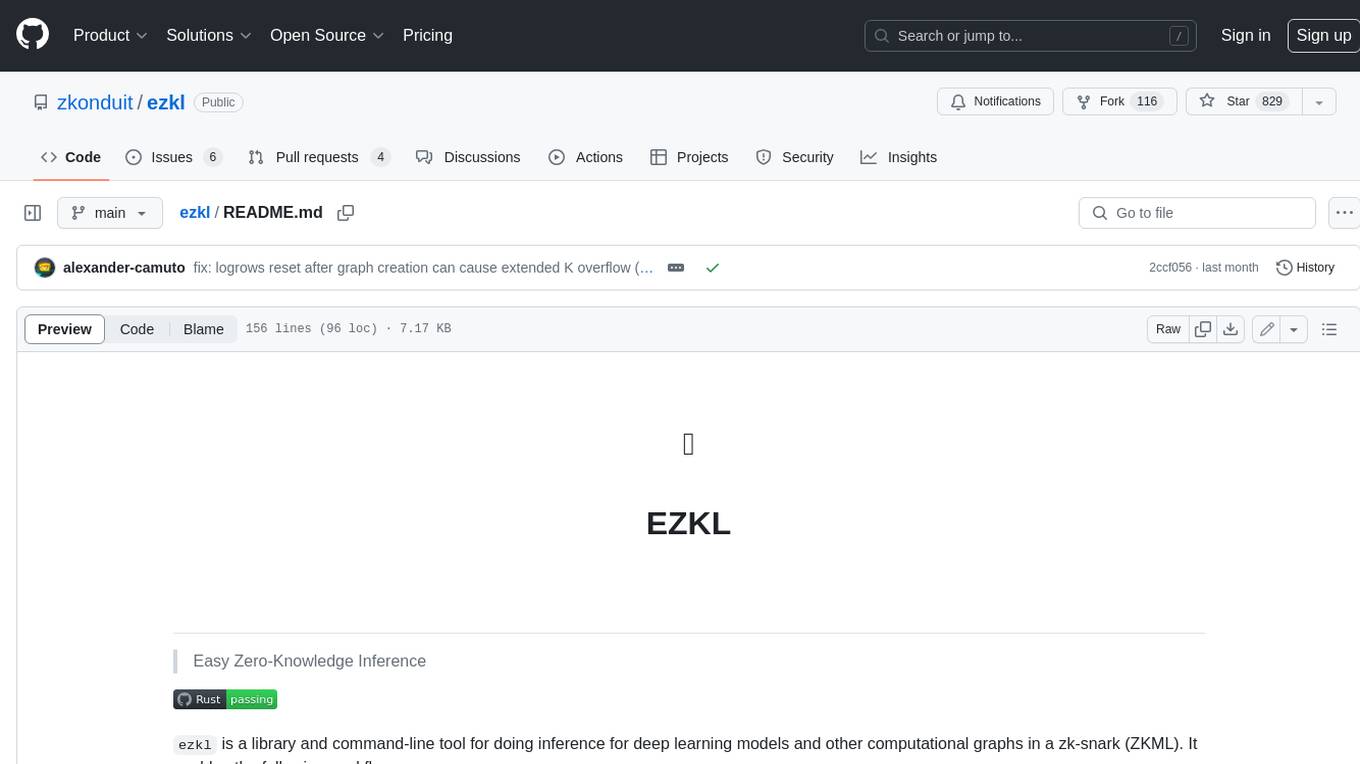
ezkl
EZKL is a library and command-line tool for doing inference for deep learning models and other computational graphs in a zk-snark (ZKML). It enables the following workflow: 1. Define a computational graph, for instance a neural network (but really any arbitrary set of operations), as you would normally in pytorch or tensorflow. 2. Export the final graph of operations as an .onnx file and some sample inputs to a .json file. 3. Point ezkl to the .onnx and .json files to generate a ZK-SNARK circuit with which you can prove statements such as: > "I ran this publicly available neural network on some private data and it produced this output" > "I ran my private neural network on some public data and it produced this output" > "I correctly ran this publicly available neural network on some public data and it produced this output" In the backend we use the collaboratively-developed Halo2 as a proof system. The generated proofs can then be verified with much less computational resources, including on-chain (with the Ethereum Virtual Machine), in a browser, or on a device.
For similar tasks

llama-on-lambda
This project provides a proof of concept for deploying a scalable, serverless LLM Generative AI inference engine on AWS Lambda. It leverages the llama.cpp project to enable the usage of more accessible CPU and RAM configurations instead of limited and expensive GPU capabilities. By deploying a container with the llama.cpp converted models onto AWS Lambda, this project offers the advantages of scale, minimizing cost, and maximizing compute availability. The project includes AWS CDK code to create and deploy a Lambda function leveraging your model of choice, with a FastAPI frontend accessible from a Lambda URL. It is important to note that you will need ggml quantized versions of your model and model sizes under 6GB, as your inference RAM requirements cannot exceed 9GB or your Lambda function will fail.

llava-docker
This Docker image for LLaVA (Large Language and Vision Assistant) provides a convenient way to run LLaVA locally or on RunPod. LLaVA is a powerful AI tool that combines natural language processing and computer vision capabilities. With this Docker image, you can easily access LLaVA's functionalities for various tasks, including image captioning, visual question answering, text summarization, and more. The image comes pre-installed with LLaVA v1.2.0, Torch 2.1.2, xformers 0.0.23.post1, and other necessary dependencies. You can customize the model used by setting the MODEL environment variable. The image also includes a Jupyter Lab environment for interactive development and exploration. Overall, this Docker image offers a comprehensive and user-friendly platform for leveraging LLaVA's capabilities.
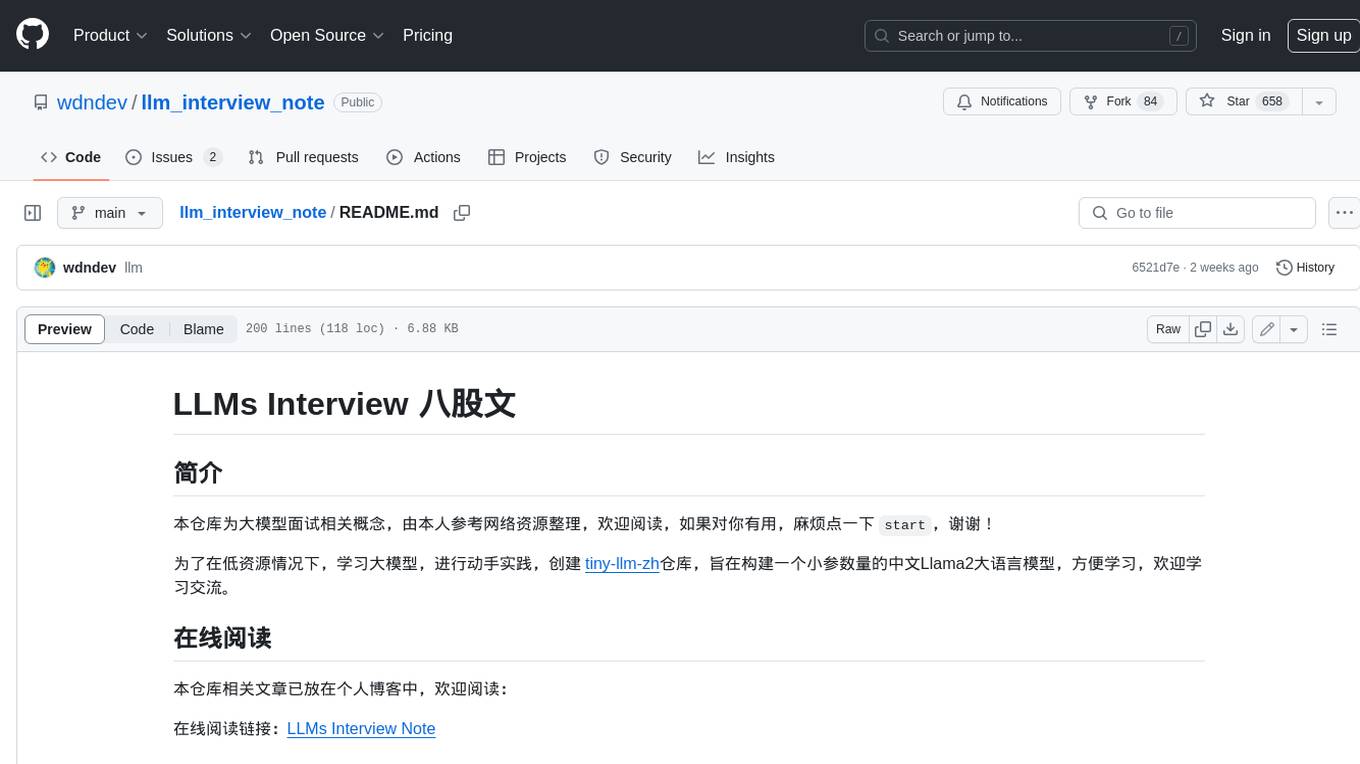
llm_interview_note
This repository provides a comprehensive overview of large language models (LLMs), covering various aspects such as their history, types, underlying architecture, training techniques, and applications. It includes detailed explanations of key concepts like Transformer models, distributed training, fine-tuning, and reinforcement learning. The repository also discusses the evaluation and limitations of LLMs, including the phenomenon of hallucinations. Additionally, it provides a list of related courses and references for further exploration.
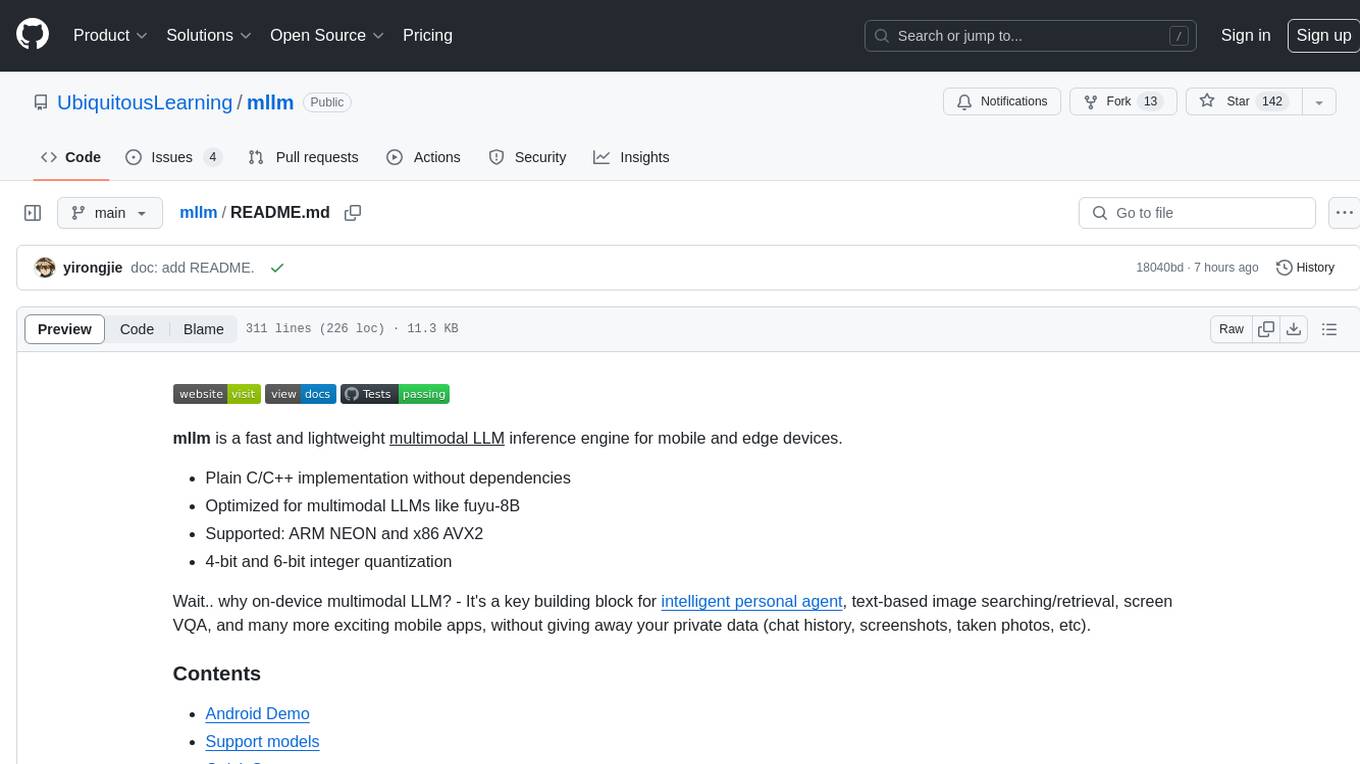
mllm
mllm is a fast and lightweight multimodal LLM inference engine for mobile and edge devices. It is a Plain C/C++ implementation without dependencies, optimized for multimodal LLMs like fuyu-8B, and supports ARM NEON and x86 AVX2. The engine offers 4-bit and 6-bit integer quantization, making it suitable for intelligent personal agents, text-based image searching/retrieval, screen VQA, and various mobile applications without compromising user privacy.
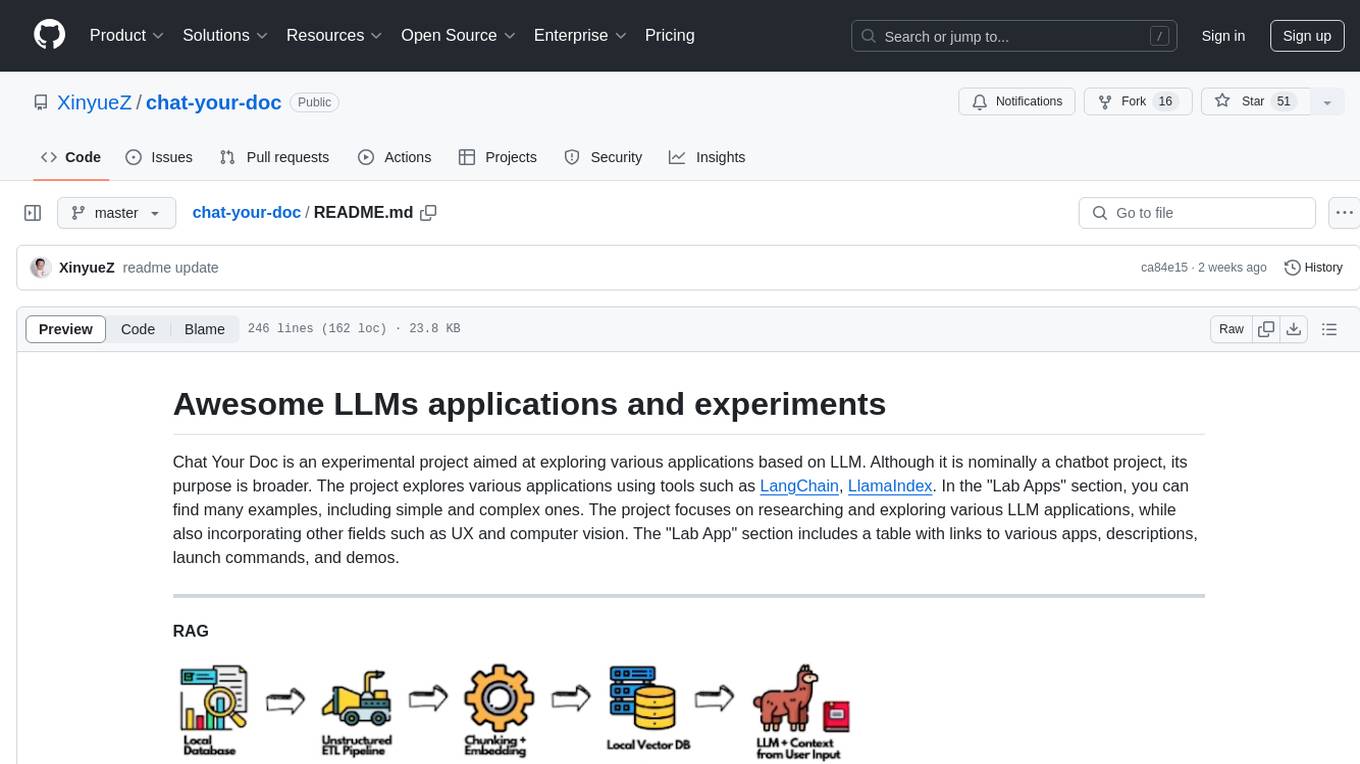
chat-your-doc
Chat Your Doc is an experimental project exploring various applications based on LLM technology. It goes beyond being just a chatbot project, focusing on researching LLM applications using tools like LangChain and LlamaIndex. The project delves into UX, computer vision, and offers a range of examples in the 'Lab Apps' section. It includes links to different apps, descriptions, launch commands, and demos, aiming to showcase the versatility and potential of LLM applications.
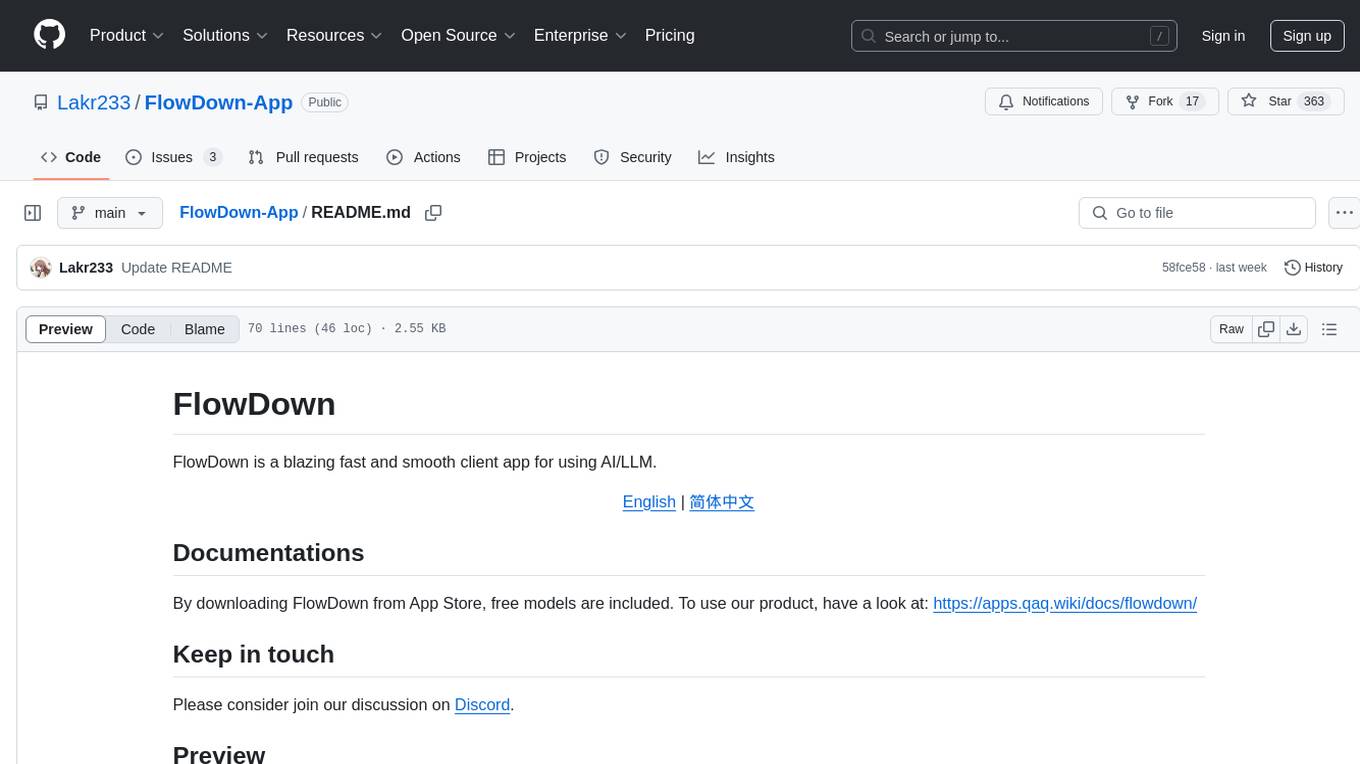
FlowDown-App
FlowDown is a blazing fast and smooth client app for using AI/LLM. It is lightweight and efficient with markdown support, universal compatibility, blazing fast text rendering, automated chat titles, and privacy by design. There are two editions available: FlowDown and FlowDown Community, with various features like chat with AI, fast markdown, privacy by design, bring your own LLM, offline LLM w/ MLX, visual LLM, web search, attachments, and language localization. FlowDown Community is now open-source, empowering developers to build interactive and responsive AI client apps.

VisionCraft
The VisionCraft API is a free API for using over 100 different AI models. From images to sound.
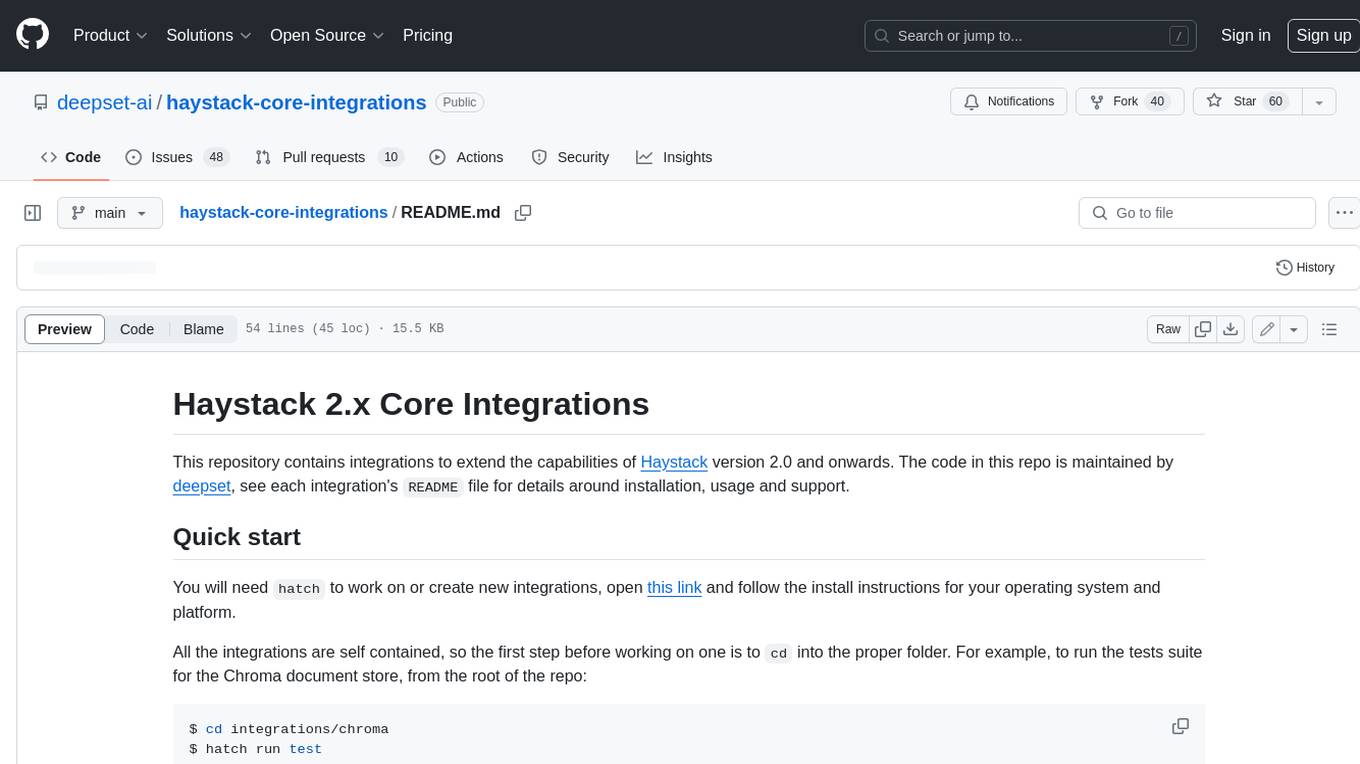
haystack-core-integrations
This repository contains integrations to extend the capabilities of Haystack version 2.0 and onwards. The code in this repo is maintained by deepset, see each integration's `README` file for details around installation, usage and support.
For similar jobs

sweep
Sweep is an AI junior developer that turns bugs and feature requests into code changes. It automatically handles developer experience improvements like adding type hints and improving test coverage.

teams-ai
The Teams AI Library is a software development kit (SDK) that helps developers create bots that can interact with Teams and Microsoft 365 applications. It is built on top of the Bot Framework SDK and simplifies the process of developing bots that interact with Teams' artificial intelligence capabilities. The SDK is available for JavaScript/TypeScript, .NET, and Python.

ai-guide
This guide is dedicated to Large Language Models (LLMs) that you can run on your home computer. It assumes your PC is a lower-end, non-gaming setup.

classifai
Supercharge WordPress Content Workflows and Engagement with Artificial Intelligence. Tap into leading cloud-based services like OpenAI, Microsoft Azure AI, Google Gemini and IBM Watson to augment your WordPress-powered websites. Publish content faster while improving SEO performance and increasing audience engagement. ClassifAI integrates Artificial Intelligence and Machine Learning technologies to lighten your workload and eliminate tedious tasks, giving you more time to create original content that matters.

chatbot-ui
Chatbot UI is an open-source AI chat app that allows users to create and deploy their own AI chatbots. It is easy to use and can be customized to fit any need. Chatbot UI is perfect for businesses, developers, and anyone who wants to create a chatbot.

BricksLLM
BricksLLM is a cloud native AI gateway written in Go. Currently, it provides native support for OpenAI, Anthropic, Azure OpenAI and vLLM. BricksLLM aims to provide enterprise level infrastructure that can power any LLM production use cases. Here are some use cases for BricksLLM: * Set LLM usage limits for users on different pricing tiers * Track LLM usage on a per user and per organization basis * Block or redact requests containing PIIs * Improve LLM reliability with failovers, retries and caching * Distribute API keys with rate limits and cost limits for internal development/production use cases * Distribute API keys with rate limits and cost limits for students

uAgents
uAgents is a Python library developed by Fetch.ai that allows for the creation of autonomous AI agents. These agents can perform various tasks on a schedule or take action on various events. uAgents are easy to create and manage, and they are connected to a fast-growing network of other uAgents. They are also secure, with cryptographically secured messages and wallets.

griptape
Griptape is a modular Python framework for building AI-powered applications that securely connect to your enterprise data and APIs. It offers developers the ability to maintain control and flexibility at every step. Griptape's core components include Structures (Agents, Pipelines, and Workflows), Tasks, Tools, Memory (Conversation Memory, Task Memory, and Meta Memory), Drivers (Prompt and Embedding Drivers, Vector Store Drivers, Image Generation Drivers, Image Query Drivers, SQL Drivers, Web Scraper Drivers, and Conversation Memory Drivers), Engines (Query Engines, Extraction Engines, Summary Engines, Image Generation Engines, and Image Query Engines), and additional components (Rulesets, Loaders, Artifacts, Chunkers, and Tokenizers). Griptape enables developers to create AI-powered applications with ease and efficiency.


